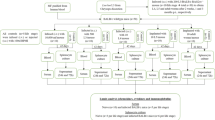Abstract
Human lymphatic filariasis is a chronic helminth infection caused byWuchereria bancrofti andBrugia malayi. Wide spectrum of clinical manifestations are seen in different clinical groups of filariasis patients which comprises asymptomatic patients with circulating microfilaria (MF), individuals with chronic lymphatic obstruction (CP), Endemic normals (EN) who are asymptomatic and amicrofilaraemic or the relatively rare tropical pulmonary eosinophilia (TPE). The cellular immune response to this infection varies in different clinical groups of filarial patients. ranging from normal lymphocyte proliferative response in EN individuals to lymphocyte hyporesponsiveness in MF to total parasite antigen [Brugia malayi antigen (BMA)]. But in response to recombinant filarial antigen (pRJ51) the lymphocyte proliferation is restored in MF patients. Interestingly the lymphocytes from MFs responded normally to parasite antigen when EN serum was added in the culture whereas sera from MFs failed to revert the lymphocyte hyporesponsiveness. In order to study the molecular mechanisms responsible for parasite antigen specific lymphocyte hyporesponsiveness, we analysed both the Th1 and Th2 type cytokine gene expression profile in different clinical groups of filarasis patients. MF individuals expressed elevated Th2 type cytokines like IL-4, IL-5 and IL-10 and decreased levels of IL-2 and IFN-γ in response to parasite antigen. Chronic patients have elevated levels of both Th1 and Th2 type cytokines in response to parasite antigen. The EN individuals had a purely Th1 type pattern with absence of IL-4 and IL-5 expression. These studies clearly demonstrate the role of Th2 cytokine like IL-10 in antigen specific hyporesponsiveness seen in MF patients. Any methods to arrest the progression of this disease should concentrate on the means to revert the Th2 type into Th1 type response in the MF patients either by Th1 type cytokine therapy or by using recombinant filarial antigen which stimulates the Th1 response. Further the recombinant filarial antigen which induces Th1 type cytokine response could be used for immunoprophylactic studies.
Similar content being viewed by others
References
WHO/CTD/TDR Lymphatic Filariasis in fection and disease control strategies, Report of meeting held at Malaysia, August 1994.
Theodor, J. G., Kaliraj, P., Jayachandran, S. and Jayaraman, K. (1993) Cloning, overexpression and evaluation of a recombinant fusion protein ofWuchereria bancrofti towards its application as a diagnostic agent for bancroftian filariasis. J. Helminth. 106, 413–420.
Regunathan, J., Jayaraman, K. and Kaliraj, P. (1997) Cellular immune response studies in bancroftian filariasis. J. Helminth. (In Press).
Weaver, C.T. and Enanue, E.R. (1990) The costimulatory function of antigen presenting cells. Immunol. Today. 11, 49–59.
King, C.L., Mahanty, S., Kumaraswami, V., Abrams, J.S., Ragunathan, J., Jayaraman, K., Ottesen, E.A., Nutman, T.B. (1993) Cytokine control of parasite specific anergy in human lymphatic Filariasis Preferential induction of regulatory T helper type 2 lymphocyte subsets, J. Clin. Invest. 92, 1667–1673.
Mahanty, S., King, C.L., Kumaraswami, V., Ragunathan, J., Maya, A., Jayaraman, K., Abrams, J.S., Ottesen, E.A. and Nutman, T.B. (1993). IL-4 and IL-5 secreting lymphocyte populations are preferentially stimulated by parasite-derived antigens in human tissue invasive nematode infections, J Immunol. 151, 3704–3711.
Mahanty, S., Mollis, S.N., Ravichandran, M., Abrams, J.S., Kumaraswami, V., Jayaraman, K., Ottesen, E.A. and Nutman, T.B. (1996) High levels of spontaveous and panaietc antigen-driven Interleukin-10 production are associated with antigen-specific hyporesposiveness in human lymphatic filaiasis. The Journal of Infectious Diseases, 173, 769–773.
Yazdanbakhsh, M., Sartono, E., Kruize, Y.C., Kurniawan, A., van der Pouw-Kraan, T., van der Meide, P.H., Selkirk, M.E., Partono, F., Hintzen, R.Q., van Lier, R.A. et al. (1993) Elevated levels of T cell activation antigen CD27 and increased interleukin-4 production in human lymphatic filariasis. Eur. J. Immunol 23, 3312–3317.
Maizels, R.M, Sartono, E., Kurniawan, A., Partono, F., Selkirk, M.E. and Yazdanbakhsh, M. (1995), T cell activation and the balance of antibody isotypes in human lymphatic filariasis, Parasitol. Today. 11, 150–56.
Urban, J.F.J., Madden, K.B., Svetic, A., Cheever, A., Trotta, P.P., Gause, W.C., Katona, I.M. and Finkelman, F.D. (1992) The importance of Th2 cytokines in protective immunity to nematodes. Immunol. Rev. 127, 205–210.
Ravichandran, M., Mahanty, S., Kumaraswami, V., Nutman, T.B. and Jayaraman, K. (1997) Elevated IL-10 mRNA expression and down regulation of Th1 type cytokines in microfilaremic individuals withWuchereria bancrofti infection. Parasite. Immunol. 19, 69–77.
Sher, A. and Coffman, R.L. (1992) Regulation of immunity to parasites by T cells and T cell-derived cytokines. Annu. Rev. Immunol. 10, 385–409.
Author information
Authors and Affiliations
Rights and permissions
About this article
Cite this article
Ravichandran, M., Regunathan, J., Narayanan, R.B. et al. Modulation of cellular immune response by cytokines in bancroftian filariasis. Indian J Clin Biochem 12 (Suppl 1), 27–31 (1997). https://doi.org/10.1007/BF02873051
Issue Date:
DOI: https://doi.org/10.1007/BF02873051




